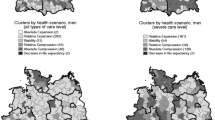Abstract
Aims
This study focuses on the public long-term care insurance (LTCI) program in Germany, considers the progress of LTCI in view of economic indicators from the 16 inland states (Länder in Germany) from 1999 to 2005, shows transitions by each state, and describes the latest problems concerning the LTCI program.
Methods
A principal component analysis was conducted using 21 variables related to LTCI.
Results
Four interpretable significant principal components were found. Component I clearly demonstrated a relationship between individual economic strength and care. It is labeled economics for care. Component II is associated with the availability of home care services. It is labeled tendency to use home care services. Component III is related to the use of nursing homes. It is labeled tendency to use nursing homes. Component IV showed a relationship between aging and needing care. It is labeled aging and needing care. The economics for care component showed the highest scores for Baden-Württemberg and lowest scores for Mecklenburg-Vorpommern. The tendency to use home care services component showed Hamburg demonstrating the highest scores and Bayern the lowest scores. The tendency to use nursing homes component showed Schleswig-Holstein with the highest scores and Bremen with the lowest scores. The aging and needing care showed Schleswig-Holstein and Berlin with the highest scores and Sachsen with the lowest scores.
Conclusions
LTCI in Germany tended to become popular according to regional needs. The tendency of benefits for each region came to be recognized as fitting each local lifestyle, economic strength, size of population, and so on. City states appeared to use home care services. Other states seemed to prefer care at nursing homes to care at home. Furthermore, people seemed to prefer using professional home care services to using care allowances at home year by year. Finally, this study suggested that the number of people needing care tended to decrease even though aging progressed.




Similar content being viewed by others
References
Bartholomeyczik S, Hunstein D (2004) Time distribution of selected care activities in home care in Germany. J Clin Nurs 13:97–104. doi:10.1046/j.1365-2702.2003.00842.x
Cuellar AE, Wiener JM (2000) Can social insurance for long-term care work? The experience of Germany. Health Aff (Millwood) 19(3):8–25
Heinemann-Knoch M, Knoch T, Korte E (2006) Invested time in private care: estimated by people in need of help and care and their private caregivers (in German). Z Gerontol Geriatr 39:413–417. doi:10.1007/s00391-006-0414-2
Rothgang H, Igl G (2007) Long-term care in Germany. Jpn J Soc Secur Policy 6(1):54–84
Sato E (2006) Long-term care insurance in Germany: analyzing its progress from the perspective of economic indicators. J Public Health 14:7–14. doi:10.1007/s10389-005-0003-7
Scharf T (2001) Ageing and intergenerational relationships in rural Germany. Ageing Soc 21:547–566. doi:10.1017/S0144686X01008388
Schulz E, Leidl R, König HH (2004) The impact of aging on hospital care and long-term care—the example of Germany. Health Policy 67:57–74. doi:10.1016/S0168-8510(03)00083-6
Schmähl W, Rothgang H (1996) The long-term costs of public long-term care insurance in Germany. Some guesstimates. In: Eisen R, Sloane FA (eds) Long-term care: economic issues and policy solutions, Kluwer Academic Publishers, Boston, pp 181-222
Statistische Ämter des Bundes und der Länder (2007) Demografischer Wandel in Deutschland
Statistisches Bundesamt (2003) Bevölkerung Deutschlands bis 2050
Statistisches Bundesamt (2001, 2003, 2005, 2007) Pflegestatistik 1999, 2001, 2003, 2005
Statistisches Bundesamt (2001, 2002, 2003, 2004, 2005, 2006, 2007) Statistisches Jahrbuch 2000, 2001, 2002, 2003, 2004, 2005, 2006
Acknowledgement
The author thanks Prof. James W. Vaupel (Max Planck Institute for Demographic Research, Germany) and Prof. Shinichi Sato (Meiji Gakuin University, Japan) for their encouragement and helpful comments on this article. This study is supported by the Universe Foundation (06-01-059).
Conflict of interest
The author confirms that there are no relevant associations that might pose a conflict of interest.
Author information
Authors and Affiliations
Corresponding author
Rights and permissions
About this article
Cite this article
Sato, E. After the launch of long-term care insurance in Germany: analyzing the transition of LTCI from 1999 to 2005 by state. J Public Health 17, 409–415 (2009). https://doi.org/10.1007/s10389-009-0265-6
Received:
Accepted:
Published:
Issue Date:
DOI: https://doi.org/10.1007/s10389-009-0265-6




